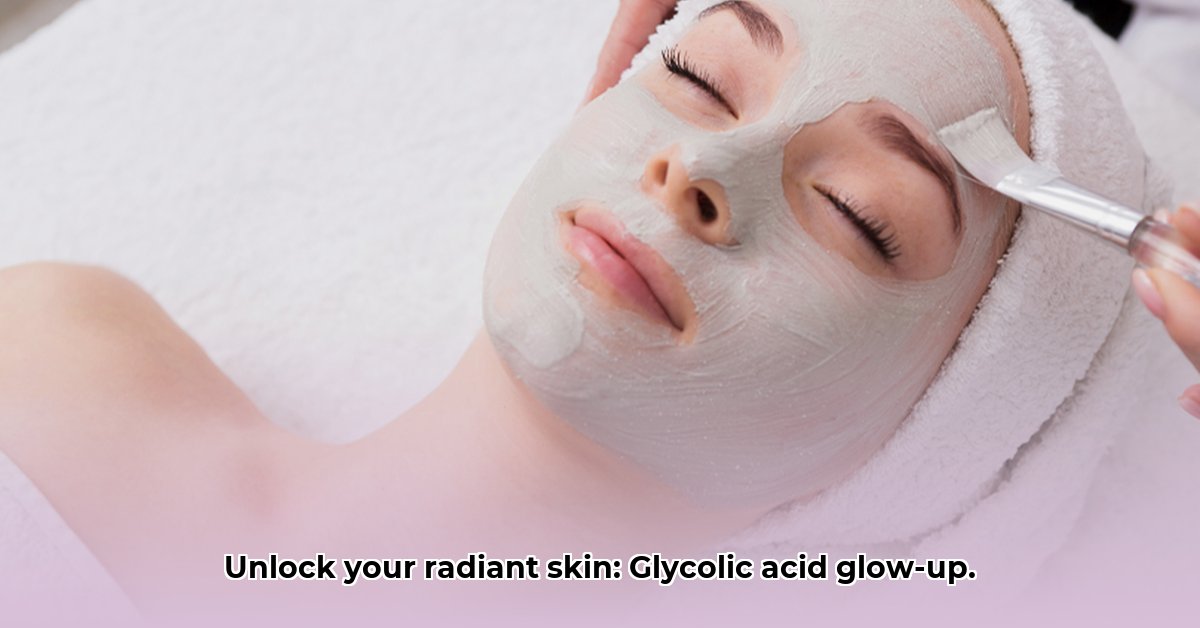Ready to unlock a radiant, healthy complexion? Glycolic acid facial washes can be a transformative addition to your skincare routine. This guide provides everything you need to know to choose the right product and use it safely and effectively. For more information on combining actives, check out this article on glycolic acid and retinol.
The Science of Glow: Understanding Glycolic Acid and Its Benefits
Glycolic acid is an alpha-hydroxy acid (AHA) celebrated for its exfoliating prowess. But how does it work? Imagine tiny Pac-Men gently nibbling away at the dead skin cells clinging to the surface of your face. Glycolic acid weakens the bonds that hold these dulling cells together, revealing the fresh, vibrant skin underneath.
This exfoliation process offers a multitude of benefits:
- Brighter Skin: By removing the barrier of dead cells, light reflects more evenly, creating a natural glow.
- Smoother Texture: Say goodbye to rough patches! Glycolic acid diminishes surface imperfections, leaving your skin feeling silky soft.
- Evened Tone: Glycolic acid can fade hyperpigmentation (sun spots, age spots, and acne scars) over time, promoting a more uniform complexion.
- Reduced Breakouts: By unclogging pores and preventing the buildup of dead skin cells, glycolic acid helps minimize acne breakouts.
- Boosted Product Absorption: Exfoliation allows your other skincare products (serums, moisturizers) to penetrate more effectively, maximizing their benefits.
- Anti-Aging Effects: Glycolic acid may stimulate collagen production, helping to reduce the appearance of fine lines and wrinkles.
Finding Your Perfect Match: Choosing the Right Glycolic Acid Facial Wash for Your Skin Type
Not all glycolic acid washes are created equal. Selecting the right one for your skin type is crucial to avoid irritation and maximize results.
Sensitive Skin: Gentle Exfoliation is Key
- Concentration: Opt for a low concentration of glycolic acid (2-5%).
- Ingredients to Seek: Look for soothing and hydrating ingredients like:
- Hyaluronic acid: A powerful humectant that attracts and retains moisture.
- Glycerin: A natural moisturizer that helps to soften and smooth the skin.
- Ceramides: Lipids that help to restore the skin’s natural barrier function.
- Aloe vera: Known for its calming and anti-inflammatory properties.
- Chamomile: Another soothing ingredient that can help to reduce redness and irritation.
- Usage: Start slowly, using the cleanser every other day or every third day. Monitor your skin for any signs of irritation and adjust accordingly.
- Avoid: Products with added fragrances, alcohol, or harsh surfactants, which can further irritate sensitive skin.
Oily or Acne-Prone Skin: Deep Cleansing and Blemish Control
- Concentration: You can typically tolerate a higher concentration of glycolic acid (5-10%).
- Ingredients to Seek:
- Salicylic acid: A beta-hydroxy acid (BHA) that penetrates pores to dissolve oil and dead skin cells. Use with caution, as it can be drying.
- Niacinamide: Helps to control oil production, minimize pores, and reduce inflammation.
- Tea tree oil: An antibacterial and anti-inflammatory ingredient that can help to fight acne.
- Usage: You may be able to use a glycolic acid cleanser daily, but pay attention to how your skin responds. If you experience dryness or irritation, reduce frequency.
- Consider: A foaming cleanser, which can help to remove excess oil and dirt.
Combination Skin: Balancing Act
- Concentration: Aim for a moderate concentration of glycolic acid (around 5%).
- Ingredients to Seek:
- Niacinamide: To balance oil production in the T-zone.
- Hyaluronic acid: To hydrate drier areas of the face.
- Usage: Use the cleanser as needed, focusing on oilier areas. You may want to use it less frequently on drier areas.
- Look For: Gel cleansers are often a good choice for combination skin.
Normal Skin: Maintaining Radiance
- Concentration: 5-8% glycolic acid is typically well tolerated.
- Ingredients to Seek: Antioxidants like Vitamin C and Green Tea extract to protect the skin from free radical damage.
- Usage: Can typically be used daily but monitor for any signs of irritation.
Crucial Step: The Patch Test
- Before incorporating any new product into your routine, perform a patch test. Apply a small amount of the cleanser to a discreet area, such as your inner arm or behind your ear. Wait 24-48 hours and monitor for any signs of irritation, redness, itching, or swelling. If you experience any of these symptoms, discontinue use.
Safety First: Potential Side Effects and Precautions
While glycolic acid is generally safe, it’s essential to be aware of potential side effects and take appropriate precautions:
- Redness and Irritation: Mild redness and irritation are common, especially when first starting to use glycolic acid. These side effects usually subside as your skin adjusts.
- Sun Sensitivity: Glycolic acid increases your skin’s sensitivity to the sun, making it more vulnerable to sun damage.
- Dryness and Peeling: Exfoliation can sometimes lead to dryness and peeling, especially at higher concentrations.
Precautions:
- Sunscreen is Non-Negotiable: Always wear a broad-spectrum sunscreen with SPF 30 or higher every day, even on cloudy days. Reapply every two hours, or more often if swimming or sweating.
- Avoid Over-Exfoliation: Don’t use multiple exfoliating products at the same time. This can lead to irritation and damage your skin’s barrier.
- Listen to Your Skin: If you experience excessive redness, irritation, or peeling, reduce the frequency of use or discontinue the product altogether.
- Pregnancy and Breastfeeding: Consult with your doctor before using glycolic acid products if you are pregnant or breastfeeding.
Frequently Asked Questions (FAQ)
- How often should I use a glycolic acid cleanser? This depends on your skin type, the concentration of glycolic acid in the product, and your skin’s tolerance. Start with every other day or every third day and gradually increase frequency as tolerated.
- Can I use other active ingredients with a glycolic acid cleanser? Use caution when combining glycolic acid with other potent actives like retinoids, benzoyl peroxide, or vitamin C. Combining these ingredients can increase the risk of irritation and dryness. Consider alternating days or using them at opposite times of the day.
- How should I store my glycolic acid cleanser? Store in a cool, dark place, away from direct sunlight and heat. This will help to preserve its effectiveness and prevent degradation of the active ingredients.
- My skin feels dry after using a glycolic acid cleanser. What can I do? Dryness is a common side effect. Combat this by:
- Using a richer moisturizer, preferably one containing ceramides, hyaluronic acid, or other hydrating ingredients.
- Applying the moisturizer immediately after cleansing, while your skin is still damp.
- Reducing the frequency of glycolic acid cleanser use.
- Is glycolic acid right for everyone? Glycolic acid may not be suitable for everyone, especially those with extremely sensitive skin, eczema, or rosacea. Always consult with a dermatologist before incorporating it into your routine, particularly if you have existing skin conditions.
- Can Glycolic Acid help with wrinkles? Glycolic acid may help reduce the appearance of fine lines and wrinkles over time by stimulating collagen production and exfoliating the skin’s surface.
- Is tingling normal when using a glycolic acid cleanser? A mild tingling sensation is normal, especially when you first start using a glycolic acid cleanser. However, if the tingling becomes intense or is accompanied by burning, redness, or irritation, rinse the cleanser off immediately and discontinue use.
- What is the ideal pH for a glycolic acid cleanser? A pH between 3.5 and 4.5 is generally considered ideal for a glycolic acid cleanser to be effective while minimizing irritation.
Glycolic Acid Concentration Guide: A Quick Reference Table
| Skin Type | Recommended Glycolic Acid Concentration (%) | Additional Beneficial Ingredients |
|---|---|---|
| Sensitive | 2-5 | Hyaluronic acid, ceramides, glycerin, aloe vera, chamomile |
| Oily/Acne-Prone | 5-10 | Salicylic acid (use cautiously!), niacinamide, tea tree oil |
| Combination | 5-8 | Niacinamide, hyaluronic acid |
| Normal | 5-8 | Antioxidants (Vitamin C, Green Tea Extract), Hyaluronic Acid |
Unveiling Radiance: Conclusion
Incorporating a glycolic acid cleanser into your skincare routine can be a game-changer for achieving a brighter, smoother, and more even-toned complexion. Remember to choose a product that’s appropriate for your skin type, start slowly, and always prioritize sun protection.
- Why Glass Boxes for Lunch Are Trending for Meal Prep - December 17, 2025
- Bento Box Glass Offers Practical, Eco-Friendly Meal Storage - December 16, 2025
- The Best Bento Box Price For Your Perfect Packed Lunch - December 15, 2025










